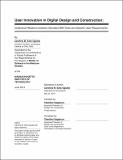User innovation in digital design and construction : dialectical relations between standard BIM tools and specific user requirements
Author(s)
Soto Ogueta, Carolina M
DownloadFull printable version (11.29Mb)
Alternative title
Dialectical relations between standard BIM tools and specific requirements
Dialectical relations between standard BIM tools and specific user requirements
Dialectical relations between standard Building Information Modeling tools and specific user requirements
Other Contributors
Massachusetts Institute of Technology. Dept. of Architecture.
Advisor
Takehiko Nagakura.
Terms of use
Metadata
Show full item recordAbstract
The use of Building Information Modeling (BIM) tools is increasing across the Architectural, Engineering and Construction (AEC) industry. This technology is being adopted in many different countries, in a wide range of types of projects, and by professionals from different disciplines. In other words, BIM tools are being applied in many different contexts of use. Consequently, the requirements of its users are becoming heterogeneous and this heterogeneity hinders the development of BIM tools that can satisfy all possible user requirements. Instead, tools are developed to satisfy more broad, general, and generic needs of the AEC industry. The present thesis examines how BIM users are adapting the standard tools to satisfy their specific requirements. Utilizing the user innovation theory as the framework of analysis, the thesis examines whether and how BIM users are adapting the tools to respond to their requirements through user innovation. Studying eight specific BIM user innovation cases, from different contexts of use, the thesis presents and analyzes the processes underlying BIM user innovation, from the starting motivation, to the final distribution of the actual innovation. This analysis has two main objectives: first, to recognize whether there is user innovation in the case of BIM tools; and second, to understand how that innovation is developed. Finally, the thesis extracts patterns of innovation, and examines whether these user innovation cases fit the model described by the user innovation theory.
Description
Thesis (S.M. in Architecture Studies)--Massachusetts Institute of Technology, Dept. of Architecture, 2012. This electronic version was submitted by the student author. The certified thesis is available in the Institute Archives and Special Collections. Cataloged from student submitted PDF version of thesis. Includes bibliographical references (p. 144-147).
Date issued
2012Department
Massachusetts Institute of Technology. Department of ArchitecturePublisher
Massachusetts Institute of Technology
Keywords
Architecture.